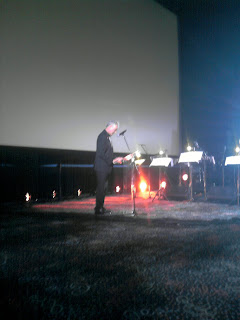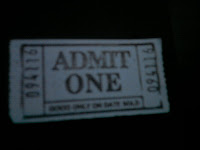Last August 26, my friends and I decided to catch the screening of the 1922 German silent film Nosferatu at the Shangri-La Cineplex as part of the 5th International Silent Film Festival. The celebration was partly sponsored by the Goethe-Institut Philippinen along with other foreign and local organizations such as Instituto Cervantes, Japan Foundation, the Italian Embassy, Embassy of Greece, National Commission for Culture and the Arts of the Philippines and the Society of Filipino Archivists for Film. Aside from the said German entry, it also featured silent films from the Philippines (Brides of Sulu), Japan (The Dawning Sky), Italy (L’Inferno), Spain (Pilar Guerra) and Greece (The Greek Miracle). Each film was accompanied by a specific musical group for the corresponding musical score. For Nosferatu, it featured German pianist and composer Stephan von Bothmer together with the FEU Chorale.
Learning my lesson well from the French Film Festival a few months back, I decided to inquire early about the tickets. Good thing I was able to get in touch with the institute through email and score 10 tickets for me and my friends along with their plus ones. I have never watched a silent film in my entire life and I have always been curious as to how they were able to work their way through the audience without the convenience of dialogues. And the screening was free, so what have I got to lose?
The Bad: Chaotic Lines
As with all free film showings, falling in line and actually getting into the theatre is quite the hassle. You will naturally see hordes of students, flocks of film connoisseurs and the occasional trippers (to which I classify our group that night) elbow to elbow to get tickets and get inside the film house. Again, it was a relief for me to reserve the needed tickets before hand so when I arrived at Cinema 2 a few minutes after 8:00 PM, I didn’t have to fall in line and hope for a chance to get in. I went directly to the ticket booth and asked for my lot of the tickets which they handed easily (without even asking for identification, I just gave my name). I asked the guy managing the ticket counter if I still have to fall in line once I secure them and he said that I didn’t have to and I can go straight in since I have reservations. Turns out, that was a lie.
According to the film brochure, the screening for Nosferatu will start at 9:00 PM. To the audience’s dismay, it wasn’t 9:00 PM sharp but 9 o’clock Filipino time. I should have known. Prior to the Nosferatu screening, the cinema house premiered with Brides of Sulu—which according to the promotional poster is only less than an hour long (49 minutes) and was supposed to start at 7:00 PM. If the organizers needed to put things back in order for the next screening, an hour of preparation would suffice for them...given that everything is properly prepared. Unfortunately, people were admitted inside only a few minutes before 10:00 PM and everyone was starting to get a bit annoyed because of it. But that turned out to be a good thing because Gem and her friend Diane, who decided to accompany us (because Ivy and Paul weren't able to make it), arrived late and the film’s tardy showing allowed us to go inside the movie house together.
 |
| Richard Künzel, director of the Goethe Institut-Philippinen giving his opening remarks before the film screening |
There was an apparent lack of order in the distribution of tickets. Although some people had reserved tickets before going, we were still asked to fall in line together with those who didn’t have one. Or that’s how it seemed like. The scene was somewhat chaotic as there were no clear lines to follow anyway. We didn’t know which line had people with tickets and which line had those who have none. This was a clear shortcoming on the part of the event organizer. There should have been organizers manning the lines of people outside the cinema house to maintain order among the moviegoers. It was quite disappointing for people like me, who reserved tickets in the first place, to be stuck in confusion as to which line to follow.
 |
| Tickets to see the perya, errr the Silent Movie Festival pala |
Once we were ushered inside the movie house, people were having a hard time finding seats. This could have been avoided had the tickets they distributed have seat numbers so people who reserved tickets before hand can naturally seat wherever they want to and be prioritized first. It’s a luxury they can afford since they went into the trouble of reserving in the first place instead of them being forced to occupy filler seats in the aisles.
But then again, the screening was free so we had no right to complain and be choosy. Sigh.
The Good: The Film and The Musical Score
 |
| The classic vampire silhouette scene in the movie that has become an icon of horror movies everywhere image courtesy of draculas.info |
Nosferatu is one those films that has a classic reputation that supersedes the movie itself. It is regarded as one of the biggest leaps in movie genius during its time. The 94 minute film is a loose adaptation of Bram Stoker’s Dracula. And since the filming company (Prana Film) could not get the original rights to distribute the film, they changed the names of novel’s protagonists and the legendary Count Dracula became Count Orlok. I’m not sure how much the film deviated from the literary work from where it was based from since I haven’t read Stoker’s novel. But I’m sensing the story is all just the same in some ways. It tells of a young man being sent away to some obscure land where stays in a dark castle to retrieve a mysterious lord disguised as the evil vampire. When the hero discovers the truth on the true nature of his landlord, he cowls in fear. The vampire then discovers that the lad has a lady waiting for him back at home and ventures to where she is to make her his. Learning his intentions, the hero travels back to his home to save his lady. With a few casualties, the climax of the film shows how good triumphs over evil when a selfless maiden sacrifices her life for the antagonist to be defeated. The vampire in the end is turned into ash by its proverbial enemy—the sun.
The fact that it’s a silent film that was able to well translate fear to its audience is already an accomplishment to begin with. We have to put our overly critical minds back in the 1920’s when the art of film was just blossoming for us to be able to fully appreciate such feat. Since no dialogues were directly heard from the characters, (albeit the narration shown on the screen) the film actors and actresses had to rely deeply on their movements and body language to relate their intent across the audience. They had to bring life to their characters by highlighting emotions of happiness, disgust and fear through their facial expressions. Although at times these portrayals and quirkiness seem exaggerated and funny to look at, I believe these “exaggerations” were necessary for the audience to have a sense of realism with the film. It is truly the mark of a good actor to be able to accomplish such translation.
 |
| Nosferatu is one scary-looking dude image courtesy of blueruins.tumblr.com |
Max Schreck was genuinely terrifying in his portrayal as the blood-sucking vampire, Count Orlok. Grotesquely made up with thick bushy eyebrows, maleficent eyes, large ears and claw-looking finger nails, his mere presence on the screen even without dramatic actions gives the movie goers the necessary goosebumps. He makes the movie a genuine horror film that makes you clutch your seat tightly when you see the monster appear on screen. Also, the fact that this movie was filmed almost 90 years ago and that it is still successful in making the main antagonist appeal evil and scary makes you appreciate Nosferatu even more.
It wouldn’t be fair for the film to be compared to recent horror movies simply because of the fact that it is a film from a different generation. Hence cinematography styles, plot development and acting would differ immensely. Lack of technological advancements certainly impeded the film to be sometimes artistically-accurate and consistent at times. However evident these shortcomings are, the film is truly a league on its own.
Aside from the character portrayal of the actors, the musical score is one of the biggest factors to consider in this film. Where the characters lack the opportunity to translate the emotions needed to the audience, the role of sound effects and music is important for the movie to attain a sense of genuine feel to it. Be it the sound of whispers, hooves of horses galloping through the forest, a creaking door and other mundane noises, it is necessary that these sounds are coherent to the scene being played out on the screen. Stephan von Bothmer, a German pianist, who was responsible for musical scoring that night was successful in this aspect. His piano accompaniment on the film added an atmosphere of suspense and dread when needed. His partner on the other hand (whom I forgot the name), who was responsible for the auxiliary sound effects is a whole different matter. He operated using an Ipad and the sounds he rendered were sometimes off-tangent to the piano accompaniment. Seriously, UFO sounds? Ugh. Kudos however to the FEU chorale for being able to consistently provide harmonic voices all throughout the film. Try operatic harmonization while standing for 95 minutes! I’m sure it’s not a very easy thing to do. I also have high praises for the soprano whose brilliant voice really gave us chills on some of the climactic scenes. Job well done.
 |
| The FEU chorale conducted by German pianist Stephan von Bothmer for the musical scoring that night |
The Verdict:
The silent film festival had a rocky start with the lack of order in terms of people falling in line to get inside the movie house. The lack of discipline among the people present and the shortcomings from the event’s organizers were to blame. However disappointing the 45 minute delay for the film screening was, it was somehow compensated, to a great degree if I may so, by the brilliance of the featured film itself and the good musical scoring. Nosferatu is truly a film that every horror movie fan should see. It was a treat to even see it on the big screen where its homage is due.
The grand daddy of all onscreen vampires certainly knows how to frighten his audience. And he can certainly trump his glittery and horny successors anytime. I wouldn't mind doing this again.
The grand daddy of all onscreen vampires certainly knows how to frighten his audience. And he can certainly trump his glittery and horny successors anytime. I wouldn't mind doing this again.


funny that outside the theater is the promotional set-up display for Breaking Dawn...hehe -dvne
ReplyDeleteNow that you mentioned it, that was pretty ironic wasn't it? Haha. I'd still prefer Nosferatu over glitter boy though.
ReplyDeleteI haven't seen this silent film however I've watched a "behind the scenes" movie about this.
ReplyDeleteIt's kind of creepy considering some facts about the making of the film.
Too bad I wasn't able to watch this and listen to FEU chorale.
How were they?
The FEU chorale provided added sound effects to the film (i.e. whispers, murmurs, etc) and the soprano (forgot her name) provided background vocals. They were consistently good throughout the 95 minute duration.
ReplyDelete